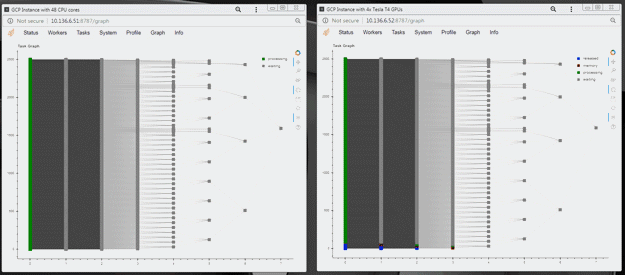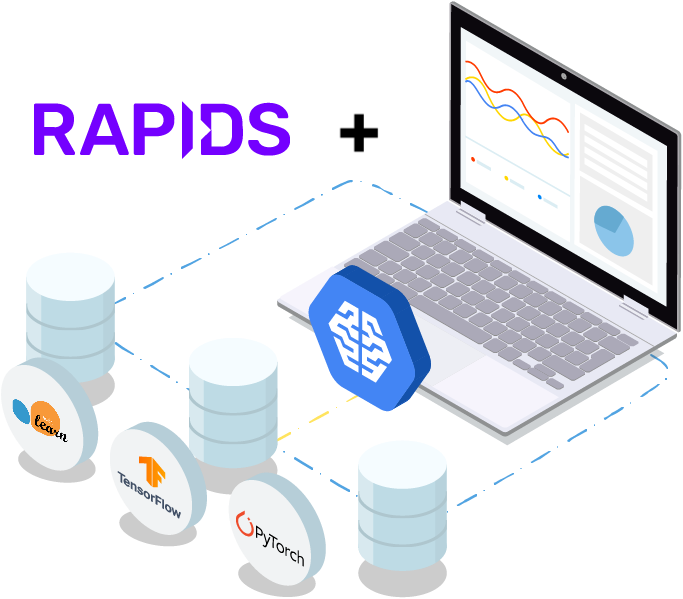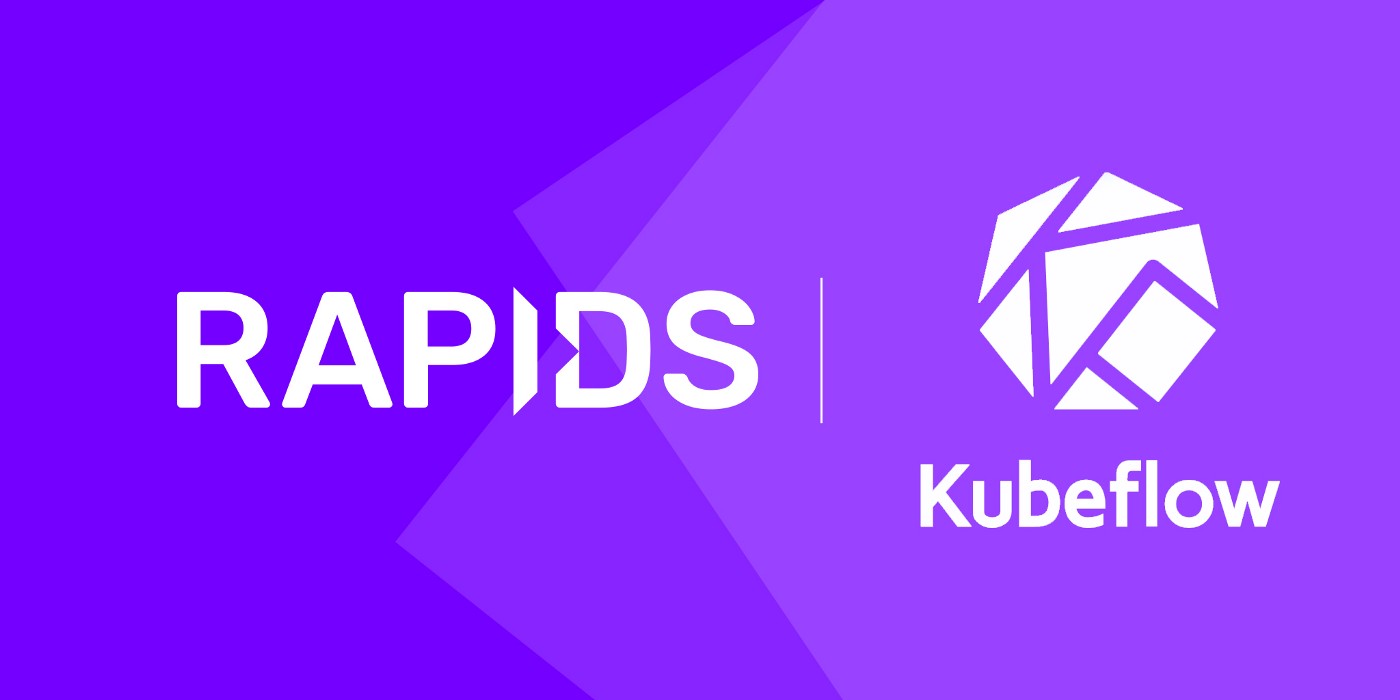NVIDIA’s Ty McKercher and Google’s Viacheslav Kovalevskyi and Gonzalo Gasca Meza jointly authored a post on using the new the RAPIDS VM Image for Google Cloud Platform. Following is a short summary. For the full post, please see the full Google article.
 If you’re a data scientist, researcher, engineer, or developer using pandas, Dask, scikit-learn, or Spark on CPUs and want to speed up your end-to-end pipeline through scale, look no further. Google Cloud’s set of Deep Learning Virtual Machine (VM) images now include an experimental image with RAPIDS, NVIDIA’s open source and Python-based GPU-accelerated data processing and machine learning libraries that are a key part of NVIDIA’s larger collection of CUDA-X AI accelerated software. CUDA-X AI is the collection of NVIDIA’s GPU acceleration libraries to accelerate deep learning, machine learning, and data analysis.
If you’re a data scientist, researcher, engineer, or developer using pandas, Dask, scikit-learn, or Spark on CPUs and want to speed up your end-to-end pipeline through scale, look no further. Google Cloud’s set of Deep Learning Virtual Machine (VM) images now include an experimental image with RAPIDS, NVIDIA’s open source and Python-based GPU-accelerated data processing and machine learning libraries that are a key part of NVIDIA’s larger collection of CUDA-X AI accelerated software. CUDA-X AI is the collection of NVIDIA’s GPU acceleration libraries to accelerate deep learning, machine learning, and data analysis.
The Deep Learning Virtual Machine images comprise a set of Debian 9-based Compute Engine virtual machine disk images optimized for data science and machine learning tasks. All images include common machine learning (deep learning, specifically) frameworks and tools installed from first boot and can be used out of the box on instances with GPUs to accelerate your data processing tasks. This post uses a Deep Learning VM which includes GPU-accelerated RAPIDS libraries.
RAPIDS is an open-source suite of data processing and machine learning libraries, developed by NVIDIA I, that enables GPU-acceleration for data science workflows. RAPIDS relies on NVIDIA’s CUDA language, allowing users to leverage GPU processing and high-bandwidth GPU memory through user-friendly Python interfaces. It includes the DataFrame API based on Apache Arrow data structures called cuDF, which will be familiar to users of pandas. It also includes cuML, a growing library of GPU-accelerated ML algorithms that will be familiar to users of scikit-learn. Together, these libraries provide an accelerated solution for ML practitioners to use requiring only minimal code changes and no new tools to learn.
RAPIDS is available as a conda or pip package, in a Docker image, and as source code.
Using the RAPIDS Google Cloud Deep Learning VM image automatically initializes a Compute Engine instance with all the pre-installed packages required to run RAPIDS. No extra steps required!
Creating a new RAPIDS virtual machine instance
Compute Engine offers predefined machine types that you can use when you create an instance. Each predefined machine type includes a preset number of vCPUs and amount of memory, and bills you at a fixed rate, as described on the pricing page.
If predefined machine types do not meet your needs, you can create an instance with a custom virtualized hardware configuration. Specifically, you can create an instance with a custom number of vCPUs and amount of memory, effectively using a custom machine type.
In this case, we’ll create a custom Deep Learning VM image with 48 vCPUs, extended memory of 384 GB, 4 NVIDIA Tesla T4 GPUs and RAPIDS support.
export IMAGE_FAMILY="rapids-latest-gpu-experimental"
export ZONE="us-central1-b"
export INSTANCE_NAME="rapids-instance"
export INSTANCE_TYPE="custom-48-393216-ext"
gcloud compute instances create $INSTANCE_NAME \
--zone=$ZONE \
--image-family=$IMAGE_FAMILY \
--image-project=deeplearning-platform-release \
--maintenance-policy=TERMINATE \
--accelerator='type=nvidia-tesla-t4,count=4' \
--machine-type=$INSTANCE_TYPE \
--boot-disk-size=1TB \
--scopes=https://www.googleapis.com/auth/cloud-platform \
--metadata='install-nvidia-driver=True,proxy-mode=project_editors'
Notes:
- You can create this instance in any available zone that supports T4 GPUs.
- The option
install-nvidia-driver=Trueinstalls NVIDIA GPU driver automatically. - The option
proxy-mode=project_editorsmakes the VM visible in the Notebook Instances section. - To define extended memory, use 1024*X where X is the number of GB required for RAM.
Running RAPIDS
We used the parallel sum-reduction test, a common HPC workload to test performance. Perform the following steps to test parallel sum-reduction::
1. SSH into the instance. See Connecting to Instances for more details.
2. Download the code required from this repository and upload it to your Deep Learning Virtual Machine Compute Engine instance:
run.shhelper `bash` shell scriptsum.pysummation Python script
You can find the code to run these tests, based on this example blog, GPU Dask Arrays, below.
3. Run the tests:
Run test on the instance’s CPU complex, in this case specifying 48 vCPUs (indicated by the -c flag):
time ./run.sh -c 48 Using CPUs and Local Dask Allocating and initializing arrays using CPU memory Array size: 2.00 TB. Computing parallel sum . . . Processing complete. Wall time create data + computation time: 695.50063515 seconds real 11m 45.523s user 0m 52.720s sys 0m 10.100s
Now, run the test using 4 (indicated by the -g flag) NVIDIA Tesla T4 GPUs:
time ./run.sh -g 4 Using GPUs and Local Dask Allocating and initializing arrays using GPU memory with CuPY Array size: 2.00 TB. Computing parallel sum . . . Processing complete. Wall time create data + computation time: 57.94356680 seconds real 1m 13.680s user 0m 9.856s sys 0m 13.832s
 |
|
| Figure 3.c: CPU-based solution | Figure 4 d: GPU-based solution |
 |
|
| Single node, 48 workers, 2TB, 11 min 35 s | Single node, 4 workers, 2TB, 58 s |
| RAPIDS VM Image for GCP | RAPIDS VM Image for GCP |
|
CPU: |
CPU: |
Here are some initial conclusions we derived from these tests:
- Processing 2 TB of data on GPUs is much faster (an ~12x speed-up for this test)
- Using Dask’s dashboard, you can visualize the performance of the reduction sum as it is executing
- CPU cores are fully occupied during processing on CPUs, but the GPUs are not fully utilized
- You can also run this test in a distributed environment. You can find more details on setting up multiple Compute Engine instances in the Google Post.
import argparse
import subprocess
import sys
import time
import cupy
import dask.array as da
from dask.distributed import Client, LocalCluster, wait
from dask_cuda import LocalCUDACluster
def create_data(rs, xdim, ydim, x_chunk_size, y_chunk_size):
x = rs.normal(10, 1, size=(xdim, ydim),
chunks=(x_chunk_size, y_chunk_size))
return x
def run(data):
(data + 1)[::2, ::2].sum().compute()
return
def get_scheduler_info():
scheduler_ip = subprocess.check_output(['hostname','--all-ip-addresses'])
scheduler_ip = scheduler_ip.decode('UTF-8').split()[0]
scheduler_port = '8786'
scheduler_uri = '{}:{}'.format(scheduler_ip, scheduler_port)
return scheduler_ip, scheduler_uri
def main():
parser = argparse.ArgumentParser()
parser.add_argument('--xdim', type=int, default=500000)
parser.add_argument('--ydim', type=int, default=500000)
parser.add_argument('--x_chunk_size', type=int, default=10000)
parser.add_argument('--y_chunk_size', type=int, default=10000)
parser.add_argument('--use_gpus_only', action="store_true")
parser.add_argument('--n_gpus', type=int, default=1)
parser.add_argument('--use_cpus_only', action="store_true")
parser.add_argument('--n_sockets', type=int, default=1)
parser.add_argument('--n_cores_per_socket', type=int, default=1)
parser.add_argument('--use_dist_dask', action="store_true")
args = parser.parse_args()
sched_ip, sched_uri = get_scheduler_info()
if args.use_dist_dask:
print('Using Distributed Dask')
client = Client(sched_uri)
elif args.use_gpus_only:
print('Using GPUs and Local Dask')
cluster = LocalCUDACluster(ip=sched_ip,n_workers=args.n_gpus)
client = Client(cluster)
elif args.use_cpus_only:
print('Using CPUs and Local Dask')
cluster = LocalCluster(ip=sched_ip,
n_workers=args.n_sockets,
threads_per_worker=args.n_cores_per_socket)
client = Client(cluster)
start = time.time()
if args.use_gpus_only:
print('Allocating arrays using GPU memory with CuPY')
rs=da.random.RandomState(RandomState=cupy.random.RandomState)
elif args.use_cpus_only:
print('Allocating arrays using CPU memory')
rs = da.random.RandomState()
x = create_data(rs, args.xdim, args.ydim,
args.x_chunk_size, args.y_chunk_size)
print('Array size: {:.2f}TB. Computing...'.format(x.nbytes/1e12))
run(x)
end = time.time()
delta = (end - start)
print('Processing complete.')
print('Wall time: {:10.8f} seconds'.format(delta))
del x
if __name__ == '__main__':
main()
In this example, we allocate Python arrays using the double data type by default. Since this code allocates an array size of (500K x 500K) elements, this represents 2 TB (500K × 500K × 8 bytes / word). Dask initializes these array elements randomly via normal Gaussian distribution using the dask.array package.
Conclusion
As you can see from the above example, the RAPIDS VM Image can dramatically speed up your ML workflows. Running RAPIDS with Dask lets you seamlessly integrate your data science environment with Python and its myriad libraries and wheels, HPC schedulers such as SLURM, PBS, SGE, and LSF, and open-source infrastructure orchestration projects such as Kubernetes and YARN. Dask also helps you develop your model once, and adaptably run it on either a single system, or scale it out across a cluster. You can then dynamically adjust your resource usage based on computational demands. Lastly, Dask helps you ensure that you’re maximizing uptime, through fault tolerance capabilities intrinsic in failover-capable cluster computing.
It’s also easy to deploy on Google’s Compute Engine distributed environment. If you’re eager to learn more, check out the RAPIDS project and open-source community website, the introductory article on the NVIDIA Developer Blog, the NVIDIA data science page, or review the RAPIDS VM Image documentation.
Acknowledgements: Ty McKercher, NVIDIA, Principal Solution Architect, Gonzalo Gasca Meza, Google, Developer Programs Engineer, Viacheslav Kovalevskyi, Google, Software Engineer









